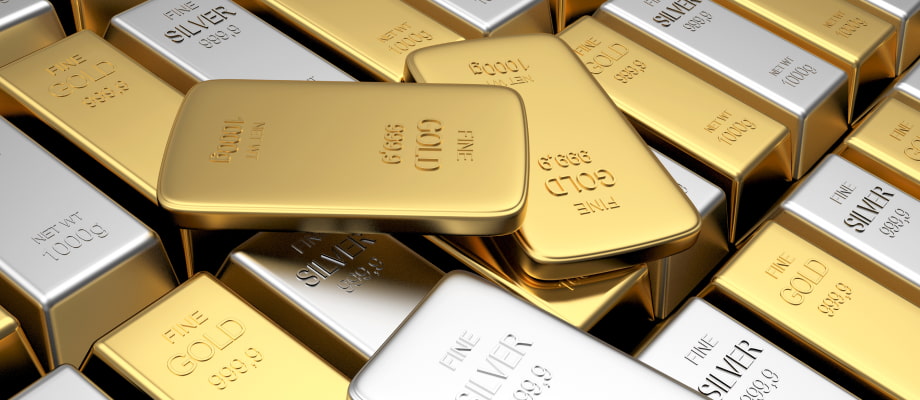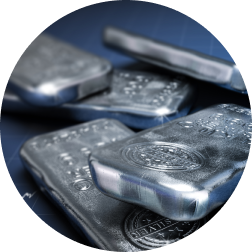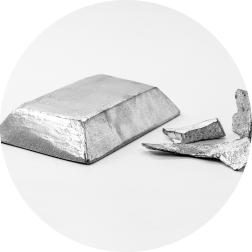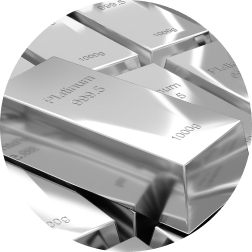Precious metals have long been cherished for their intrinsic beauty, rarity, and diverse industrial applications. From gold to silver, platinum to palladium, these metals have captivated civilisations throughout history and continue to play a pivotal role in today’s global markets.
If you have been eager to explore the world of precious metals, this complete guide sheds light on the definition of precious metals, their unique properties, and their historical significance. Plus, it sheds light on how to invest in the assets so you can easily make informed decisions.
In This Guide
What Are Precious Metals? A Complete Guide for Investors
What Are Precious Metals?

Precious metals are a group of highly valued metallic elements that possess unique characteristics and properties. You probably must be familiar with gold, silver, platinum, and palladium, as they are the most popular globally. Note that these metals are sought after for their rarity, durability, and aesthetic appeal. They have been treasured by civilisations for centuries and are considered to be of great worth in various industries and investment portfolios.
One defining feature of precious metals is their limited supply. They are relatively scarce in nature, making them inherently valuable. Their scarcity, combined with their beauty and resistance to corrosion, makes them suitable for jewellery production, decorative arts, and luxury goods.
Additionally, precious metals have diverse industrial applications, from electronics and medical devices to automotive catalysts and renewable energy technologies. Their thermal and electrical conductivity, along with their resistance to tarnishing and chemical reactions, make them indispensable in these sectors.
In the investment realm, precious metals serve as a store of value and a hedge against economic uncertainties. They provide a tangible asset that can protect against inflation and market volatility. Investors often include precious metals in their portfolios to diversify risk and preserve wealth over the long term.
The prices of precious metals are influenced by factors such as supply and demand dynamics, geopolitical events, and economic conditions, making them subject to market fluctuations. Understanding the nature of precious metals and their role in both industry and investment can help individuals make informed decisions when considering their potential benefits for personal financial goals.
How to Invest in Precious Metals
Trading commodities carries risks such as market volatility, leveraged positions, and the potential for substantial losses. To manage these risks, diversify your investments, use stop-loss and take-profit orders, and trade with funds you can afford to lose. Additionally, stay informed about market factors, adhere to a well-defined trading plan, and guard against emotional decision-making.
It is also crucial to comply with market regulations and be cautious of counterparty risk. Regularly reassessing your risk tolerance and trading strategies will help you trade responsibly and maximise profitability.
Investing in precious metals provides an avenue for diversifying one’s investment portfolio and potentially boosting your nest egg in the long run. Note that you need a credible and reliable broker listing the assets to effectively invest. Brokers not only act as intermediaries between buyers and sellers but also allow you to invest in precious metals in different ways as indicated below.
- Physical Ownership: Purchasing physical precious metals, such as gold bars, silver coins, or platinum bullion, allows investors to directly own the metal. These can be stored at home or in secure vaults. It’s crucial to consider storage costs, security measures, and liquidity when opting for physical ownership.
- Exchange-Traded Funds (ETFs): Precious metal ETFs are investment funds that trade on stock exchanges. These funds hold physical metal or derivatives tied to the metal’s price. ETFs provide convenient access to the precious metal market without the need for physical storage. They offer liquidity, transparency, and flexibility for investors.
- Precious Metal Mining Stocks: Investing in mining companies that extract and produce precious metals can be another efficient way to invest in this sector. The value of mining stocks is influenced not only by the price of the underlying metal but also by the company’s performance, production costs, and exploration success. It’s essential to research and evaluate individual mining companies before investing.
- Futures, CFDs, and Options: Trading futures contracts, CFDs, and options on precious metals allows investors to speculate on the assets’ price movements without owning the physical metal. These derivative instruments require careful consideration, as they involve leverage and can be more complex than other investment methods.
- Precious Metal IRA: Investors in the United States can consider opening a Precious Metal Individual Retirement Account (IRA). This type of account allows for the inclusion of certain approved precious metal products, providing potential tax advantages for retirement savings.
Most Popular Precious Metals
When mentioning precious metals, most investors think of gold and silver. However, being well-versed in the different types of precious metals and their functions is essential. Let’s explore the four most popular precious metals to consider investing in.
Gold

Gold is perhaps the most well-known and revered precious metal. Its enduring allure stems from its scarcity, malleability, and resistance to corrosion. Note that this metal has been a symbol of wealth and power across cultures and civilisations. Investors are drawn to it for its ability to preserve value during times of economic uncertainty and inflation. Gold serves as a hedge against currency fluctuations and acts as a store of wealth. The asset is commonly traded in the form of bars, coins, and even jewellery. Additionally, gold finds use in various industries, including electronics, dentistry, and aerospace.
Gold is not only a symbol of wealth and power but also a versatile asset that can be traded, with numerous investors engaging in trading with gold to take advantage of its value fluctuations in the financial markets.
Read about the gold trading in the UK and commodity brokers in the UK in our other comprehensive guides.
Silver

Like gold, Silver holds a unique place among precious metals due to its affordability, industrial applications, and historical role as a currency. While silver is valued for its aesthetic appeal in jewellery and silverware, it also possesses excellent thermal and electrical conductivity. As a result, silver is widely used in electronics, solar panels, and the automotive industry. Silver’s relatively lower price compared to gold makes it accessible to global investors, allowing for potential diversification within precious metal portfolios.
Palladium

Palladium’s popularity is primarily driven by its crucial role in the automotive industry. This lustrous white metal is used in catalytic converters to reduce harmful vehicle emissions. The increasing global focus on environmental regulations and the demand for cleaner emissions have propelled palladium prices to record highs. Investors are drawn to Palladium for its industrial applications and potential for capital appreciation. However, it’s important to note that palladium is a niche market, and its price can be highly volatile.
Platinum

Like its precious metal counterparts, Platinum possesses remarkable physical properties, including resistance to corrosion and high melting points. It finds extensive use in automotive manufacturing, jewellery, and chemical refining industries. Platinum is particularly sought after in the production of catalytic converters, where it helps reduce emissions from internal combustion engines. Despite its industrial significance, platinum also holds investment appeal. Its relatively limited supply and diverse applications contribute to its value as an investment asset.
Read a comprehensive IronFX review in our other article.
What is the Most Precious Metal?
As mentioned earlier, gold has consistently held the title of the most precious metal. This is primarily because the metal has a long-standing history as a store of value and a medium of exchange. It has also been used as a fiat currency for thousands of years, with civilisations recognising its inherent worth and desirability. Its scarcity and enduring beauty have also contributed to its universal appeal across cultures.
Additionally, gold has proven to be a reliable hedge against inflation and economic uncertainties. During times of market volatility or geopolitical tensions, investors often seek the safety and stability that gold provides. The asset’s demand as a safe haven has stood the test of time.
Gold’s industrial applications, such as electronics, dentistry, and aerospace, further contribute to its value. Its exceptional conductivity, malleability, and resistance to corrosion make it indispensable in various technological and scientific fields.
Pros and Cons of Investing in Precious Metals
Investing in precious metals offers a range of advantages. However, like other investments, it also has drawbacks you should be familiar with. Here are some pros and cons of investing in precious metals for the best investment decisions.

Pros
- Portfolio Diversification: Precious metals provide a way to diversify an investment portfolio. They often have a low correlation with other asset classes like stocks and bonds, which can help reduce overall portfolio risk.
- Hedge Against Inflation: Precious metals are often considered a hedge against inflation. When the value of fiat currencies decreases due to inflationary pressures, the price of precious metals tends to rise.
- Store of Value: Precious metals have been recognised as a store of value for centuries. They have inherent worth and can retain their value over time. In times of economic uncertainty or currency devaluation, precious metals can provide stability and serve as a reliable store of wealth.
- Potential Long-term Profits: If you want to build your nest egg over time, precious metals can be excellent tools to invest in. Their prices can rise based on factors such as increasing industrial demand, geopolitical tensions, or investor sentiment. As a result, you can generate profits when selling your precious metal holdings.
Cons
- Volatility and Price Fluctuations: Like any investment, precious metals are subject to price volatility and fluctuations. Their prices can be influenced by various factors, such as economic indicators, geopolitical events, and market sentiment, which may affect your investments and leave you with losses.
- Lack of Income Generation: Unlike stocks, precious metals do not generate regular income in the form of dividends or interest. Investors only rely on capital appreciation for potential profits.
- Storage and Insurance Costs: Owning physical precious metals requires appropriate storage and security measures. Investors may incur additional costs for secure storage facilities, safety deposit boxes, or insurance coverage to protect their investments.
FAQs
The most expensive precious metal is currently rhodium. Rhodium is a rare and highly reflective metal primarily used in catalytic vehicle converters. Its price surged in recent years due to increasing demand and limited supply.
No. Diamond is not a precious metal but a precious gemstone, prized for its brilliance and durability. Precious metals typically refer to metallic elements like gold, silver, platinum, and palladium, known for their rarity, beauty, and industrial applications.
There are traditionally 8 elements in the list of precious metals, including gold, silver, platinum, palladium, rhodium, ruthenium, iridium, and osmium. These metals have been valued for their unique properties, durability, and various industrial uses throughout history.
The best way to invest in precious metals is by purchasing the assets to sell later for profits. If you do not want to go through the hassle of looking for secure storage for your assets, consider investing in precious metals through derivative trading. This can be through CFDs, ETFs, futures contracts, etc. You can also invest in mining companies’ shares.
Conclusion
Precious metals hold a significant place in human history, serving as a medium of exchange, a store of value and a symbol of wealth across cultures. Before investing in precious metals, consider the potential drawbacks, such as price volatility, storage costs, and more. Market conditions and investor sentiment can impact the assets’ values, emphasising the need for thorough research and risk management. For beginners, start with small investment capital as you become familiar with the market. Remember, the choice of investment method should align with investment requirements and risk tolerance.
In addition to precious metals, it’s also worth considering the potential of investing in other valuable resources such as lithium. As the demand for lithium-ion batteries continues to grow, driven by the rising popularity of electric vehicles and renewable energy storage, investing in lithium can present an opportunity to participate in this expanding market.






